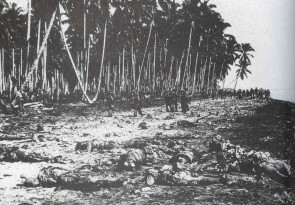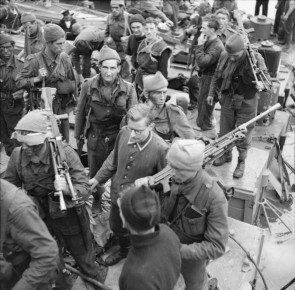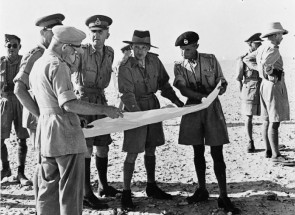Guadalcanal. Japanese Colonel Ichiki believes only a few Americans defend Henderson Airfield along the Tenaru River. At 1.30 AM, he sends 100 troops across the Tenaru River, supported by machineguns and mortars, but 2500 Marines mow them down with machinegun fire and anti-tank guns firing canister shot. At 2.30 AM, Ichiki sends another wave of 150 to 200 troops but they are also wiped out. Marine artillery and mortars find their range and wreak havoc as Ichiki’s troops regroup between each attack. At 5 AM, Ichiki sends another wave along the beach but Marines turn their machineguns and artillery to stop them also. At 7 AM, the Marines counterattack inland and surround the remaining Japanese on the coast, who are then eliminated by five M3 Stuart tanks and strafing from US fighters. Japanese casualties are 740 dead, including Colonel Ichiki who is killed or commits suicide, and 15 taken prisoner (only 30 survivors escape back to the landing site at Taivu Point). US Marine lose 44 killed.
Guadalcanal. Overnight, Japanese Colonel Ichiki moves his 770 troops forward to within a few miles of Henderson Field, stopping at 4.30 AM. Ichiki is still fooled by intelligence reports that a minimal American presence holds the airfield. However, after the clash of patrols at Koli Point yesterday, US Colonel Clifton Cates deploys 1st and 2nd battalions 1st Marine Regiment, plus two 37mm anti-tank guns loaded with canister shot, along the West bank of the Tenaru River (known as Alligator Creek to the Americans), while 75mm and 105mm artillery range their guns on the East side of Alligator Creek. In addition, US auxiliary carrier USS Long Island flies off 19 Grumman Wildcat fighters (VMF 223) and 12 Douglas Dauntless dive bombers (VMSB 232) to Henderson Field.
Big Commando raid on Dieppe today. Raid was still continuing this evening. Just conceivably the first step in an invasion, or a try-out for the first step, though I don’t think so. The warning that was broadcast to the French people that this was only a raid and they were not to join in would in that case be a bluff.
Guadalcanal. At 1 AM, Japanese destroyers Kagero, Kagikaze, Maikaze, Urakaze, Isokaze and Hamakaze land 916 troops (Ichiki Detachment) at Taivu Point, 22 miles East of the US positions at Lunga Point. Colonel Ichiki leaves 100 troops as a rear guard and leads 800 men towards the Marines. At dawn, they halt 9 miles East of the Lunga perimeter but send forward a patrol of 38. As a diversion from the landings, Japanese aircraft attack the US airstrip at Henderson Field. However, Australian coastwatchers warn the Americans of the landings and Captain Charles Brush leads a patrol of 60 Marines and 4 native scouts to investigate. At noon, the patrols meet at Koli Point (Japanese lose 33 killed, Marines have 3 dead and 3 wounded). US B-17 bombers attack the Japanese destroyers off Guadalcanal. A bomb hits Hagikaze destroying No. 3 (“Y”) gun turret and damaging the rudder and prop-shafts (33 killed, 13 wounded). Hagikaze proceeds at 6 knots to Truk for emergency repairs.
Between 6 AM and 9.13 hours AM 10 miles off the Southeast coast of Cuba, U-553 attacks convoy TAW-13, sinking British MV Emipre Bede carrying cotton from Egypt to USA (2 killed, 43 survivors picked up by British corvette HMS Pimpernel), American SS John Hancock carrying 10,517 tons of sugar from Hawaii via the Panama Canal (all 38 crew and 11 gunners in 4 lifeboats picked up after 3 hours by a British corvette) and Swedish MV Blankaholm (5 killed, 23 survivors).
From George Kopp’s [1] last letter from Marseilles (after some rigmarole about the engineering work he has been doing): “…I am about to start production on an industrial scale. But I am not at all certain that I shall actually do so, because I have definite contracts with my firm, which has, I am afraid, developed lately connections which reduce considerably its independence and it is possible that another firm would eventually profit by my work, which I should hate since I have no arrangements at all with the latter and will not, for the time being, be prepared to sign any. If I am compelled to stop, I really don’t know what I am going to do; I wish some of my very dear friends to whom I have written repeatedly would not be as slow and as passive as they seem to be. If no prospects open in this field, I contemplate to make use of another process of mine, related to bridge-building [, which, you may remember, I have put into successful operation at San Mateo before the war.”]
Between 5.26 and 9.20 AM off Matveev Island in Pechora Sea, U-209 attacks a Soviet convoy with gunfire, sinking tugs Komsomolec & Komiles and barges Sh-500 & P-4 (305 crew, port workers and political prisoners killed, 23 survivors picked up by tug Nord and minesweepers T-54 & T-62).
Kriegsmarine believes Allied are ships are moving up the East coast of South America in the safety of the neutral Brazilian coastal waters. In a blatant act of aggression, U-507 sinks 3 Brazilian passenger ships SS Baependy (55 crew and 215 passengers, including 145 troops, killed; 36 survivors), MV Araraquara (66 crew and 65 passengers killed, 11 survivors) and SS Annibal Benévolo (67 crew and 83 passengers killed, 4 survivors) between midnight and 9.13 AM off Aracaju, Brazil.
At 3.58 AM 570 miles West of Ireland, U-705 attacks convoy SC 95, sinking American SS Balladier (13 killed, 32 survivors in 1 lifeboat, 2 rafts and a float rescued by another convoy SC 95 vessel, American SS Norluna).
Horrabin was broadcasting today, and as always we introduced him as the man who drew maps for Well’s Outline of History and Nehru’s Glimpses of World History. [1] This had been extensively trailed and advertised beforehand, Horrabin’s connection with Nehru being naturally a draw for India. Today the reference to Nehru was cut out from the announcement – N. Being in prison and therefore having become bad.
Operation Pedestal. Tanker SS Ohio, which is carrying a crucial cargo of fuel to Malta, is still afloat despite listing badly with her back broken. SS Ohio, abandoned overnight, is reboarded and taken in tow by British destroyers HMS Penn, HMS Bramham & HMS Ledbury, and minesweeper HMS Rye. SS Ohio is hit by several more bombs, causing many breaks in the tow line, but she is held together and buoyed up by the warships lashed to her. Despite an enormous hole in the bow caused by a torpedo 2 days ago, British freighter MV Brisbane Star reaches Malta at 4.15 PM (Captain Frederick Neville Riley is awarded the Distinguished Service Order).











